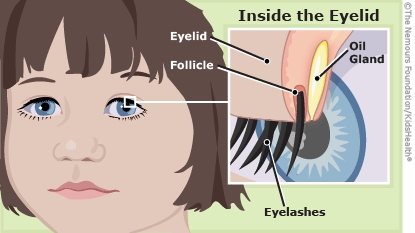Blepharitis: How to Care for Your Child
Blepharitis is inflammation (swelling and irritation) along the edge of the eyelids. The eyes burn and become red and itchy, and flakes form near the eyelashes. Blepharitis (blef-eh-RITE-is) can be caused by a reaction to something (for example, makeup, smoke, or contact lenses), an infection, or clogged glands or follicles in the eyelids. Depending on the cause, it may happen only once or keep coming back. Treatments can help with symptoms and help prevent blepharitis from coming back.
Use these instructions to care for your child.


-
If you know what caused the blepharitis, help your child avoid it. For example, they can stop wearing certain types of makeup, not smoke or be around cigarette smoke, or try a different type of contact lenses.
-
Give your child any prescribed medicines or eye ointments as directed by your health care provider.
-
Be sure you and your child wash hands with soap and water before and after touching the eyelids.
-
To help with symptoms, have your child:
-
Place a clean, moist, warm (not hot) washcloth over closed eyes for 5–10 minutes 2–4 times a day. Rewet the cloth in warm water if it starts to cool. After the washcloth has been on the eye for 5–10 minutes, use it to massage the eyelid for about 30 seconds, removing any flakes or crusting.
-
Gently wash the closed eyelids 2–4 times a day with plain water or a small amount of baby shampoo mixed with water or eyelid wash (available in drugstores without a prescription). Rinse well.
-
Use artificial tears (available in drugstores without a prescription) to help with dry eyes.
-
To help keep blepharitis from coming back:
-
Avoid any triggers that have brought it on in the past.
-
Clean the eyes every day by gently washing the closed eyelids with plain water or a small amount of baby shampoo mixed with water or eyelid wash and then rinse well.
-
Get treatment for eczema, dandruff, and other skin conditions.
-
Help your child remember to:
-
Follow your health care provider's recommendations for:
-
whether it's OK for your child to wear contact lenses
-
whether your child should avoid using eye makeup
-
when to schedule a follow-up visit and whether your child should see an ophthalmologist (eye doctor)

Your child:
-
has symptoms that do not improve or that get worse
-
develops a bump on the eyelid
-
has eye pain
-
has blurry vision or other vision changes

Who gets blepharitis? Although anyone can get it, it's more common in people who have:
-
eczema (dry, itchy, irritated skin)
-
dandruff (flakes on the scalp)
-
environmental allergies
-
psoriasis (a skin condition that can also involve the joints and nails)
-
rosacea (red, bumpy skin on the face)
-
too much of certain germs living near their eyelids
It also can happen in people using some types of medicines, including retinoids used to treat acne.
What problems can happen from blepharitis? Blepharitis can cause a stye (bump in the eyelid) or problems with eyelashes growing in crooked or falling out. If someone keeps getting blepharitis for many years, it can cause scarring of the eyelids or problems with the cornea (the outside layer of the eye).